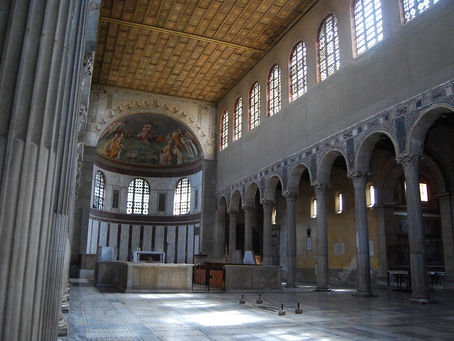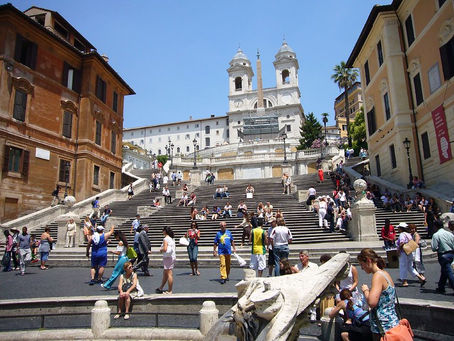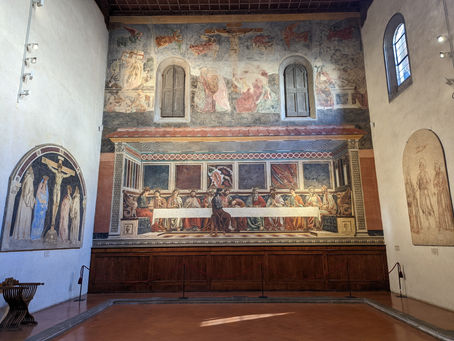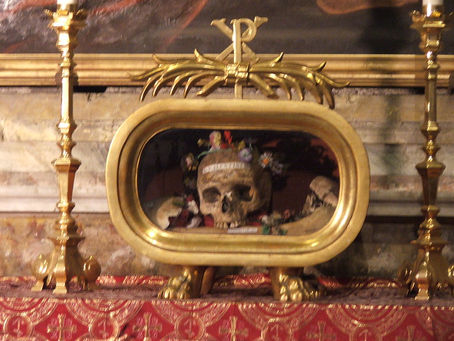top of page
Blog: Blog2
Search


Rome Top Five - My Next Visit
This post outlines my personal top five sites for my next visit to Rome. Unlike a list for a first-timer, this itinerary assumes more leisure time and dives deep into personal interests. We'll explore the hidden 9th-century mosaics of Santa Prassede, the stunning sculpture of Santa Cecilia in Trastevere, the Baroque masterpieces of the Borghese Gallery, the layered history of the Capitoline Hill, and the revolutionary art of Caravaggio in San Luigi de' Francesi.

Rick Bessey
Oct 277 min read


Pilgrimage Sunday: St. Peter's Basilica
St. Peter's Basilica is a magnificent basilica. It is the resting place of Peter the Apostle. Originally constructed by Constantine, it was rebuilt in the Renaissance and decorated in the Baroque style. It is lavish and grand and impressive.

Rick Bessey
Aug 23 min read


Saints and Relics Saturday: Church of Domine Quo Vadis
Outside of the main city of Rome, along the ancient Appian Way - the main road of Ancient Rome, sits the church of Domine Quo Vadis. The phrase comes from the legend of Peter (specifically, the apocryphal Acts of Peter) and is said to be the words that Peter spoke to the risen Christ. Peter was fleeing the persecutions of Rome, and on the way out of the city on the main road, the Appian Way, he came across the risen Christ, who was headed into Rome.

Rick Bessey
Aug 11 min read


Churches Friday: The Church of St. Ignazio
The church of St. Ignazio is a marvel of decoration and will provide you with an excellent opportunity to exercise your eyes! The most magnificent artwork is above you, for when you look up, the ceiling opens and you are rewarded with the vision of St. Ignatius being taken to heaven. Look around, though, and see the host of characters that are accompanying him at the edges of the ceiling. All is masterfully done. The ceiling was painted by the artist Andra Pozzo in the later

Rick Bessey
Jul 312 min read


Curiosa Thursday: Bramante's Tempietto
The Tempietto is a beautiful example of Renaissance architecture in Rome. Bramante created this structure in 1502, drawing on classical Roman examples with perfect proportions. It sits in the courtyard of San Pietro in Montorio, commemorating what was once thought to be St. Peter’s martyrdom site. This was based on a misinterpretation of the term “meta,” which we now know referred to the circus in the Vatican area. The Tempietto is a perfect stop during a lovely walk in Trast

Rick Bessey
Jul 301 min read


Walkabout Wednesday: Temple of Hadrian
You will find the ruins of ancient Rome throughout the city. One reason is that re-use has preserved many of the magnificent structures of Imperial Rome. The Temple of Hadrian is a fascinating example of this. Although the structure as a whole no longer stands, you can easily see the wonder of the building, for the large columns and the entablature survive in a modern building.
The remaining wall of the Temple of Hadrian sits in its own Piazza, so there is plenty of time t

Rick Bessey
Jul 291 min read


Ancient Tuesday: Castel Sant'Angelo or the Mausoleum of Hadrian
The Castel Sant'Angelo, or Mausoleum of Hadrian, is a large, circular structure on the Tiber River, visible from St. Peter's Basilica. Originally Hadrian's mausoleum, its solid construction made it an ideal papal fortress, connected by a visible passage to St. Peter's. It also served as a prison, holding Caterina Sforza and the fictional Mario Cavaradossi from Puccini's Tosca.

Rick Bessey
Jul 282 min read


Masterpiece Monday: The Brancacci Chapel
The Brancacci Chapel is a magnificent place to understand Renaissance painting, where Michelangelo himself studied. Revolutionary artist Masaccio created early Renaissance art here, sharing work with Masolino, whose International/Gothic style provides immediate juxtaposition. The frescoes, focusing on St. Peter's life, include "The Tribute Money." Located in Florence's Oltrarno, it's a must-see if open.

Rick Bessey
Jul 272 min read


Pilgrimage Sunday: St. Paul Outside the Walls
The Basilica of Saint Paul Outside the Walls (San Paolo fuori le Mura) is the final resting place of St. Paul. The earliest structure over his burial site was created under Constantine in 324, and the church was rebuilt multiple times, including after a devastating fire in 1823. Decorations of Paul's life are throughout this, Rome's second largest church.

Rick Bessey
Jul 261 min read


Saints and Relics Saturday: St. Dominic and the Devil's Stone in Santa Sabina
On Rome's Aventine Hill, the church of Santa Sabina holds a large rock. Legend says the Devil, angered by St. Dominic's prayers, threw it at him, missing. The rock remains, with holes from the Devil's talons visible. The church grounds also feature a beautiful park with views from the parapet.

Rick Bessey
Jul 251 min read


Churches Friday: Santa Maria degli Angeli
Michelangelo repurposed the ruins of Emperor Diocletian's baths into the church Santa Maria degli Angeli, where the massive scale of ancient structures is layered into a beautiful basilica. The Termini train station, named for "baths," is across the street, and Piazza della Repubblica, a common filming scene, is directly outside.

Rick Bessey
Jul 241 min read


Curiosa Thursday: Palazzo Zuccari
Just down the street from the Spanish Steps is this fabulous doorway of the Palazzo Zuccari. Art historians refer to the period immediately after the High Renaissance as the Mannerist period (1520-1600). The artwork of this period is often referred to as surprising, peculiar, or unexpected, and the doorway certainly embodies that. Today the building houses a library for art historians.

Rick Bessey
Jul 231 min read


Walkabout Wednesday: Spanish Steps
The Spanish Steps in Rome lead from Piazza di Spagna, home to a Bernini fountain and the Spanish Embassy, to the Trinità dei Monti church with its Roman obelisk. This area, once home to poet Yeats, offers city views and upscale shopping. Visitors should note that sitting on the steps is prohibited.

Rick Bessey
Jul 221 min read


Ancient Tuesday: Baths of Caracalla
A visit to the Baths of Caracalla, though in ruins, reveals the immense scale of Roman construction and its core brickwork. Constructed in the early 200s AD, these baths were used until 500 AD and served as a place for bathing, exercise, relaxation, and possibly included a library. The site is easily accessible by taxi or bus.

Rick Bessey
Jul 211 min read


Masterpiece Monday: Last Supper of Andrea del Castagno
You will find this gem of a masterpiece near the church of San Marco in Florence. The fresco of the Last Supper in the convent of Sant'Apollonia, completed in 1447, reflects the genius of Renaissance art. This large work, nearly 15 feet high and 32 feet wide, showcases linear perspective. The artist's humor is evident in details like St. Bartholomew's reaction to St. Andrew's knife. Admission is free, and the location is convenient.

Rick Bessey
Jul 202 min read


Pilgrimage Sunday: Santa Maria Maggiore
Santa Maria Maggiore holds sway on the Esquiline Hill, a grand building set apart by its piazza and hill. Legend says Pope Liberius received a vision in 358 to build a church where snow falls, and a miracle snow did take place, leading to this church dedicated to Mary. Inside the church is the manger of Christ. The piazza also has a large taxi
St. Lawrence (Lorenzo, in Italian), was a deacon of the church who was killed on August 10, 258 in the Roman persecutions under the

Rick Bessey
Jul 191 min read


Saints and Relics Saturday: St. Valentine, Santa Maria in Cosmedin
The head of St. Valentine rests in the church, Santa Maria in Cosmedin, with his name visible on the skull. The church is better known for the Bocca della Verità, or "Mouth of Truth," a manhole-sized marble face made famous in the movie Roman Holiday. Legend says it bites the hand of anyone who tells a lie.

Rick Bessey
Jul 181 min read


Churches Friday: Santa Maria in Aracoeli
The church Santa Maria in Aracoeli on the Capitoline Hill has a fascinating foundation story. Emperor Augustus had a vision of a woman presenting a child on an altar, leading him to build the "altar of heaven," or "ara coeli," which names the church. Its nave columns are from ancient ruins, one noted "from the chambers of Augustus." The 124 marble steps were added after the Black Death of 1348.

Rick Bessey
Jul 171 min read


Curiosa Thursday: EUR - Mussolini's Rome
The EUR district takes visitors outside central Rome to a virtually deserted area. Planned by Mussolini in the 1930s for the 1942 World's Fair, its architecture reflects the period, making one feel stepped back in time. It is a place to immerse oneself in stark WWII architecture.

Rick Bessey
Jul 161 min read


Walkabout Wednesday: The Capitoline Hill
The Capitoline Hill, ancient Rome's most sacred space with the Temple of Jupiter, is now a beautiful piazza designed by Michelangelo, housing the Capitoline Museums. Its approach features a gentle staircase and statues of Castor and Pollux. In the center is a reproduction of Marcus Aurelius's equestrian statue. Behind the buildings are outstanding views of the Roman Forum.

Rick Bessey
Jul 151 min read
bottom of page


